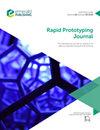Non-local and local criteria based on the extended finite element method (XFEM) for fracture simulation of anisotropic 3D-printed polymeric components
IF 3.6
4区 工程技术
Q1 ENGINEERING, MECHANICAL
引用次数: 2
Abstract
Purpose The purpose of this study is to develop an efficient numerical procedure for simulating the effect of printing orientation, as one of the primary sources of anisotropy in 3D-printed components, on their fracture properties. Design/methodology/approach The extended finite element method and the cohesive zone model (XFEM-CZM) are used to develop subroutines for fracture simulation. The ability of two prevalent models, i.e. the continuous-varying fracture properties (CVF) model and the weak plane model (WPM), and a combination of both models (WPM-CVF) are evaluated to capture fracture behavior of the additively manufactured samples. These models are based on the non-local and local forms of the anisotropic maximum tangential stress criterion. The numerical models are assessed by comparing their results with experimental outcomes of 16 different configurations of polycarbonate samples printed using the material extrusion technique. Findings The results demonstrate that the CVF exaggerates the level of anisotropy, and the WPM cannot detect the mild anisotropy of 3D-printed parts, while the WPM-CVF produces the best results. Additionally, the non-local scheme outperforms the local approach in terms of finite element analysis performance, such as mesh dependency, robustness, etc. Originality/value This paper provides a method for modeling anisotropic fracture in 3D-printed objects. A new damage model based on a combination of two prevalent models is offered. Moreover, the developed subroutines for implementing the non-local anisotropic fracture criterion enable a reliable crack propagation simulation in media with varying degrees of complication, such as anisotropy.基于扩展有限元法(XFEM)的各向异性3D打印聚合物部件断裂模拟的非局部和局部准则
目的本研究的目的是开发一种有效的数值程序来模拟打印方向对其断裂性能的影响,打印方向是3D打印部件各向异性的主要来源之一。设计/方法/方法使用扩展有限元方法和粘结区模型(XFEM-CZM)开发用于裂缝模拟的子程序。评估了两个常用模型的能力,即连续变化断裂特性(CVF)模型和弱平面模型(WPM),以及这两个模型的组合(WPM-CVF),以捕捉添加制造样品的断裂行为。这些模型基于各向异性最大切向应力准则的非局部和局部形式。通过将数值模型的结果与使用材料挤出技术印刷的16种不同配置的聚碳酸酯样品的实验结果进行比较来评估数值模型。结果表明,CVF夸大了各向异性的水平,并且WPM不能检测到3D打印零件的温和各向异性,而WPM-CVF产生了最好的结果。此外,非局部方案在有限元分析性能方面优于局部方法,如网格依赖性、鲁棒性等。原始性/值本文提供了一种在3D打印对象中建模各向异性裂缝的方法。基于两种常用模型的组合,提出了一种新的损伤模型。此外,开发的用于实现非局部各向异性断裂准则的子程序能够在具有不同复杂程度(如各向异性)的介质中进行可靠的裂纹扩展模拟。
本文章由计算机程序翻译,如有差异,请以英文原文为准。
求助全文
约1分钟内获得全文
求助全文
来源期刊

Rapid Prototyping Journal
工程技术-材料科学:综合
CiteScore
8.30
自引率
10.30%
发文量
137
审稿时长
4.6 months
期刊介绍:
Rapid Prototyping Journal concentrates on development in a manufacturing environment but covers applications in other areas, such as medicine and construction. All papers published in this field are scattered over a wide range of international publications, none of which actually specializes in this particular discipline, this journal is a vital resource for anyone involved in additive manufacturing. It draws together important refereed papers on all aspects of AM from distinguished sources all over the world, to give a truly international perspective on this dynamic and exciting area.
-Benchmarking – certification and qualification in AM-
Mass customisation in AM-
Design for AM-
Materials aspects-
Reviews of processes/applications-
CAD and other software aspects-
Enhancement of existing processes-
Integration with design process-
Management implications-
New AM processes-
Novel applications of AM parts-
AM for tooling-
Medical applications-
Reverse engineering in relation to AM-
Additive & Subtractive hybrid manufacturing-
Industrialisation
 求助内容:
求助内容: 应助结果提醒方式:
应助结果提醒方式:


